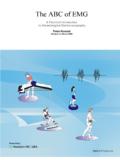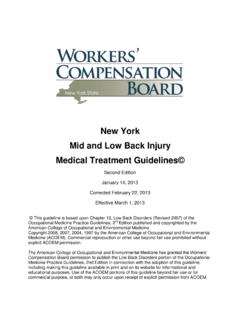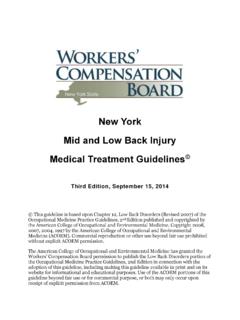Transcription of The Ergonomics of Adult Car Seat Design and Comfort
1 The Ergonomics of Adult Car Seat Design and Comfort By Honor e McGraw History of Ergonomics The word Ergonomics comes from two Greek words. Ergo meaning work and nomos meaning laws. Ergonomics can be thought of as the application of science in human life for Comfort and Ergonomics studies the human fit and looks for ways to decrease fatigue and discomfort through product When products fit the user, and are in line with the user's activity, the result can be increased productivity and less stress. Ergonomics came about as a scientific discipline in the 1940s with the realization that the benefits of increasingly complex technical equipment would not be actualized if the users did not fully understand how to use these These user-machine issues first became prominent in the military sector where machine operators experienced increasingly physical and cognitive For example, concern about fatigue in munitions factories in the UK during WWI led to the creation of the Industrial Fatigue Research Board.
2 Which examined the effect of working conditions on health and In 1949 physiologists and psychologists came together to establish the Ergonomics Research Society (ERS), which became the first such professional body in the Although early research was focused on work environments, the importance of Ergonomics has become increasingly recognized in the Design of consumer products such as cars and Over time, some differences in terminology came about in different In the USA the term human factors was used interchangeably with the UK term Ergonomics . Popular usage of the terms resulted in human factors referring more to the cognitive areas of the discipline (perception, memory, etc.)
3 Whereas Ergonomics may refer more specifically to the physical aspects (workplace layout, light, heat, noise, etc.).4 In 2009 the Ergonomics Research Society was renamed the Institute of Ergonomics and Human Factors (IEHF). to demonstrate the popular usage of both terms and to highlight the breadth of the growing On the Road A new (2016) survey from the AAA Foundation for Traffic Safety found that American drivers spend an average of more than 293 hours behind the wheel each That is roughly equivalent to seven 40-hour weeks at the The number of miles driven for 2015 was a increase from A comparison of drivers in the USA and in Sweden found that 50% of those questioned in both countries, reported low back With increasing amounts of time spent driving, researchers are putting more effort into understanding the physiological and psychological consequences.
4 The term repetitive driving injury has been used to describe complaints such as foot cramps, low back pain, stiff neck, sore shoulders from poor posture, stress, and tension, which have been reported by Repetitive driving injuries are a form of work-related musculoskeletal disorder (WMSD).7 WMSDs are described as disorders of the muscles, joints, nerves, tendons, ligaments, cartilage, or spinal discs which mainly occur in the neck, back, arms, and These disorders reflect gradual or chronic Epidemiological studies have shown that low back pain and lumbar disc herniation are positively associated with the amount of time spent driving.
5 8 In addition, prolonged exposure to driving cars has been identified as a risk factor for other musculoskeletal disorders (MSDs).9 Individuals who drive cars as part of their job are at significant risk. This risk is increased for those who drive for 20 hours per week or Increasing use of the car as a mobile office ( using a laptop and making business calls), has other associated health Driving occupations make up several of the top 15 occupations with associated musculoskeletal Gyi et al. found that within a group of business drivers, 65% reported low back discomfort, 43% neck discomfort and 40% shoulder Extended time behind the wheel has been correlated with low back trouble at greater risk than sitting and standing jobs or Gyi found that that people exposed to over 4 hours of driving per day were more than twice as likely to suffer from low back pain compared to those with over 4.
6 Hours of sedentary work per From an economic perspective, low back pain related to driving contributes to the over $100 billion spent on low back pain each year in the United Seating in Motion Versus Stationary Seating There are quite a few important differences between what the body experiences while stationary sitting, for example at a desk, and sitting in a car seat. Stationary sitting allows body to be supported by both feet flat on floor and arms resting by sides or supported on arm rests. When a driver uses a steering wheel, their hands and arms are higher than while working at a Operating the brake and accelerator pedals requires extending the legs to a greater degree than stationary The use of upper and lower extremities can be even more involved if driving a vehicle with manual Driving places greater restrictions to posture in a more confined space than in a non automobile Drivers experience the forces associated with deceleration and acceleration.
7 Unlike individuals in non moving seats, drivers of automobiles are subjected to vibrations which are directly related to characteristics of the vehicle and of the road surface or Vibrations are transmitted to driver's buttocks and back of the occupant along the vertebral axis via the base and back of the seat .8 The pedals and steering wheel transmit additional vibrations into the driver's body through the feet and Prolonged exposure to vibration can result in a range of physiological issues such as postural instability (weakening of lumbar musculature), cramps, motion sickness, and numbness, which can be exacerbated by being in a seated ,16 The presence of vibration in the motor vehicle environment has been cited as a potentiating factor in the increased presence of low back pain and disc herniations in There is quite a bit of variation in the perception and tolerance of General guidelines have been developed that suggest minimizing vibration transmission in the 4 to 8 Hz In addition to vibrations, drivers also experience bumps, lateral forces as the vehicle turns.
8 And awkward postures as they attempt to interact with items in the vehicle. ergonomic Design Principles Anthropometry is the science that seeks to measure the range of body sizes in a The idea that the seat should fit the sitter is the most universally employed concept in seating Anthropometric data vary considerably between regional For example, anthropometric data reflect that Scandinavian populations tend to be taller, while Asian and Italian populations tend to be Anthropometric measures for a given population are ranked by size and described as percentiles 2 In contrast to the idea of the seat fitting the sitter.
9 It is common practice in ergonomic Design that seats should accommodate the 5th percentile (small) female to the 95th percentile (large) ,17 Modern vehicle marketing often takes a one size fits all approach and requires that seat designs accommodate more than 95 percent of the target user. 2,17. Anthropometric databases compare people of different ages and Databases can include information about static dimensions, such as lower leg length or functional dimensions such as The most commonly referenced database used in Design is from military data collected in the1970s and 1980s, and is known as the ANSUR However, there are important differences between the military and civilian populations, especially with regard to body weight and related In 2000, the Civilian American and European Surface Anthropometry Resource (CAESAR) was created by the Society of Automotive Engineers (SAE)
10 To measure civilian populations in North America and Many manufacturers utilize both databases to guide ergonomic In addition to fit parameters, which take into account ranges of population anthropometric measures, feel parameters and support parameters are also associated with seat Comfort and ergonomic seat Feel parameters are related to the physical contact between the sitter and the seat, affecting the local sensation of Comfort . Examples of these parameters include pressure, shear stress, temperature, humidity, and The sitter's body detects the effects of the Design feel parameters through nerve receptors in the skin and superficial underlying Feel parameter levels are set using subjective user assessments and objective measurements made with tools which measure factors such as pressure and sweat Due to the difficulty of obtaining objective measurements, these parameters are poorly One of the most frequently investigated feel parameter is the pressure distribution where the sitter meets the seat.






